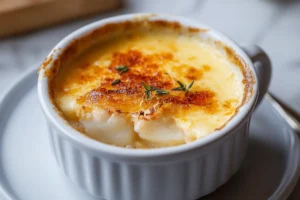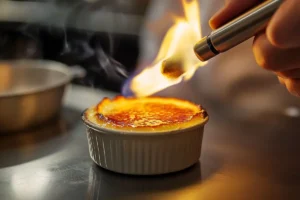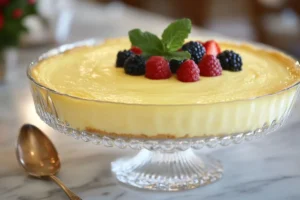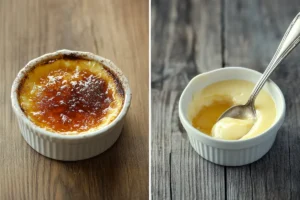If you’ve ever found yourself staring at a dessert menu, wondering whether to order crème brûlée or custard, you’re not alone. These two creamy, egg-based desserts often leave people scratching their heads. While they share some similarities, the difference between crème brûlée and custard lies in their textures, preparation methods, and presentation. In this article, we’ll dive deep into what sets these two apart, so you can confidently choose—or even make—your favorite.
Why Understanding the Difference Matters
Knowing the difference between crème brûlée and custard isn’t just for foodies or professional chefs. Whether you’re hosting a dinner party or simply satisfying your sweet tooth, understanding these desserts can elevate your culinary skills. Plus, it’s always fun to impress your friends with a bit of dessert trivia!
A Brief History of Crème Brûlée and Custard
Both crème brûlée and custard have rich histories that add to their charm. Custard, for instance, dates back to ancient Rome, where it was a staple in many recipes. On the other hand, crème brûlée—often associated with French cuisine—has a more debated origin, with some claiming it was first created in England. Regardless of their beginnings, both desserts have stood the test of time and remain beloved worldwide.
What is Custard?
At its core, custard is a simple yet versatile dessert made from a few basic ingredients: eggs, milk or cream, and sugar. The magic happens when these ingredients are gently cooked, resulting in a smooth, creamy texture that can be enjoyed on its own or used as a filling for pies, tarts, and pastries.
There are two main types of custard: baked custard and stirred custard.Baked custard, like flan or crème caramel, is cooked in the oven, while stirred custard, such as pastry cream, is made on the stovetop. Each type has its own unique texture and uses, making custard a go-to dessert for many occasions.
What is Crème Brûlée?
Crème brûlée, often referred to as the “queen of custards,” is a luxurious dessert that takes the basic custard recipe to the next level. Its name literally means “burnt cream” in French, and for good reason. The dessert features a rich, creamy custard base topped with a layer of caramelized sugar, creating a delightful contrast between the smooth custard and the crunchy topping.
What sets crème brûlée apart is its preparation. After baking the custard, a thin layer of sugar is sprinkled on top and caramelized using a kitchen torch or broiler. This final step not only adds a unique texture but also enhances the dessert’s visual appeal, making it a favorite in fine dining establishments.
Key Similarities Between Crème Brûlée and Custard
Despite their differences, crème brûlée and custard share some common ground. Both are egg-based desserts that rely on the gentle cooking of eggs to achieve their signature creaminess. Additionally, they both use milk or cream as a primary ingredient, giving them a rich and indulgent flavor.
However, the similarities end when it comes to presentation and texture. While custard is often served as a creamy, spoonable dessert, crème brûlée boasts a caramelized sugar topping that adds a layer of complexity and sophistication.
Texture and Consistency
When it comes to texture, the difference between crème brûlée and custard is like night and day. Custard is smooth, creamy, and often spoonable, making it a versatile dessert that can be served in bowls, used as a filling, or even poured over cakes. On the other hand, crème brûlée has a dual texture: a velvety custard base topped with a thin, crackly layer of caramelized sugar. This contrast is what makes crème brûlée so unique and satisfying to eat.
Cooking Methods
The way chefs prepare these desserts also sets them apart. You can make custard using two main methods: baking or stovetop cooking. For baked custard, like flan, you cook it slowly in a water bath to ensure even heat distribution. For stirred custard, such as pastry cream, you whisk it continuously on the stovetop to prevent curdling.
Crème brûlée, however, follows a more specific process. The custard base is baked in ramekins until set, and then a thin layer of sugar is sprinkled on top and caramelized using a kitchen torch or broiler. This final step requires precision to achieve the perfect balance between a creamy base and a crisp topping.
Ingredients and Ratios
While both desserts share similar ingredients—eggs, milk or cream, and sugar—the ratios and additional components differ slightly. Custard typically uses a higher proportion of milk to cream, resulting in a lighter texture. In contrast, crème brûlée often uses more cream, giving it a richer, more decadent flavor.
Another key difference is the use of vanilla. Crème brûlée almost always includes vanilla beans or extract to enhance its flavor profile, while custard can be flavored in various ways, from chocolate to fruit purees.
Serving and Presentation
Presentation is where crème brûlée truly shines. It’s traditionally served in individual ramekins, with the caramelized sugar topping adding a touch of elegance. The act of cracking the sugar layer with a spoon is part of the experience, making it a favorite for special occasions.
Custard, on the other hand, is more versatile in its presentation. It can be served in bowls, used as a filling for pastries, or even layered in trifles. Its simplicity makes it a comforting, everyday dessert.
Flavor Profiles
The flavor profiles of these desserts also differ. Custard is mild and creamy, allowing it to pair well with a variety of toppings and accompaniments. Crème brûlée, with its caramelized sugar topping, offers a more complex flavor profile. The contrast between the creamy custard and the slightly bitter, crunchy sugar creates a symphony of textures and tastes that’s hard to resist.
Step-by-Step Guide to Making Custard
Making custard at home is easier than you might think. Here’s a simple recipe to get you started:
- Ingredients:
- 2 cups milk
- 4 egg yolks
- 1/2 cup sugar
- 1 tsp vanilla extract
- Instructions:
- Heat the milk in a saucepan until warm but not boiling.
- In a separate bowl, whisk the egg yolks and sugar until pale and creamy.
- Gradually pour the warm milk into the egg mixture, whisking constantly.
- Return the mixture to the saucepan and cook over low heat, stirring continuously, until it thickens.
- Remove from heat, stir in the vanilla, and let it cool before serving.
For a baked version, pour the mixture into ramekins and bake in a water bath at 325°F (160°C) for about 40 minutes.
Step-by-Step Guide to Making Crème Brûlée
Ready to impress your guests? Here’s how to make crème brûlée:
- Ingredients:
- 2 cups heavy cream
- 4 egg yolks
- 1/2 cup sugar (plus extra for caramelizing)
- 1 vanilla bean or 1 tsp vanilla extract
- Instructions:
- Preheat your oven to 325°F (160°C).
- Heat the cream in a saucepan with the vanilla bean (split and scraped) until warm.
- In a bowl, whisk the egg yolks and sugar until creamy.
- Gradually add the warm cream to the egg mixture, whisking constantly.
- Strain the mixture into ramekins and bake in a water bath for 40-45 minutes.
- Let the custards cool, then refrigerate for at least 2 hours.
- Before serving, sprinkle a thin layer of sugar on top and caramelize using a kitchen torch or broiler.
Common Mistakes to Avoid
- Overcooking Custard: This can cause the eggs to curdle, resulting in a grainy texture. Always cook on low heat and stir continuously.
- Uneven Caramelization: When making crème brûlée, ensure the sugar layer is even and not too thick to avoid burning.
Crème Brûlée vs. Custard: Which One Should You Choose?
So, what’s the verdict? While both crème brûlée and custard are creamy, egg-based desserts, they cater to different tastes and occasions. If you’re looking for a simple, versatile dessert, custard is your go-to. But if you want to impress with a luxurious, textured treat, crème brûlée is the way to go.
Pro Tip: If you’re new to making these desserts, start with a basic custard recipe to get comfortable with the techniques. Once you’ve mastered custard, you’ll find it much easier to tackle the caramelized sugar topping of crème brûlée. Both desserts are perfect for experimenting with flavors—try adding citrus zest, spices, or even a splash of espresso to create your own signature version!
Frequently Asked Questions About Crème Brûlée and Custard
If you’re still curious about the difference between crème brûlée and custard, you’re not alone! Here are some of the most common questions people ask, along with clear, concise answers.
1. Is Crème Brûlée a Type of Custard?
Yes, crème brûlée is a specific type of baked custard. While all crème brûlée is custard, not all custard is crème brûlée. The key difference lies in the caramelized sugar topping that gives crème brûlée its signature crunch.
2. Can I Make Crème Brûlée Without a Torch?
Absolutely! If you don’t have a kitchen torch, you can use your oven’s broiler to caramelize the sugar topping. Just keep a close eye on it to prevent burning.
3. What’s the Difference Between Custard and Pudding?
While both are creamy desserts, custard is egg-based and relies on eggs for thickening, whereas pudding is typically thickened with starch (like cornstarch). This gives custard a richer, silkier texture compared to pudding.
4. Can I Use Custard as a Base for Crème Brûlée?
Yes, you can! The custard base for crème brûlée is essentially the same as a classic baked custard. The only difference is the addition of a caramelized sugar topping.
5. How Do I Store Leftover Crème Brûlée?
Store leftover crème brûlée in the refrigerator, but wait to caramelize the sugar topping until just before serving. This ensures the topping stays crisp and doesn’t dissolve into the custard.
Crème Brûlée vs. Custard: Which One Should You Choose?
So, what’s the verdict? While both crème brûlée and custard are creamy, egg-based desserts, they cater to different tastes and occasions. If you’re looking for a simple, versatile dessert, custard is your go-to. But if you want to impress with a luxurious, textured treat, crème brûlée is the way to go.




